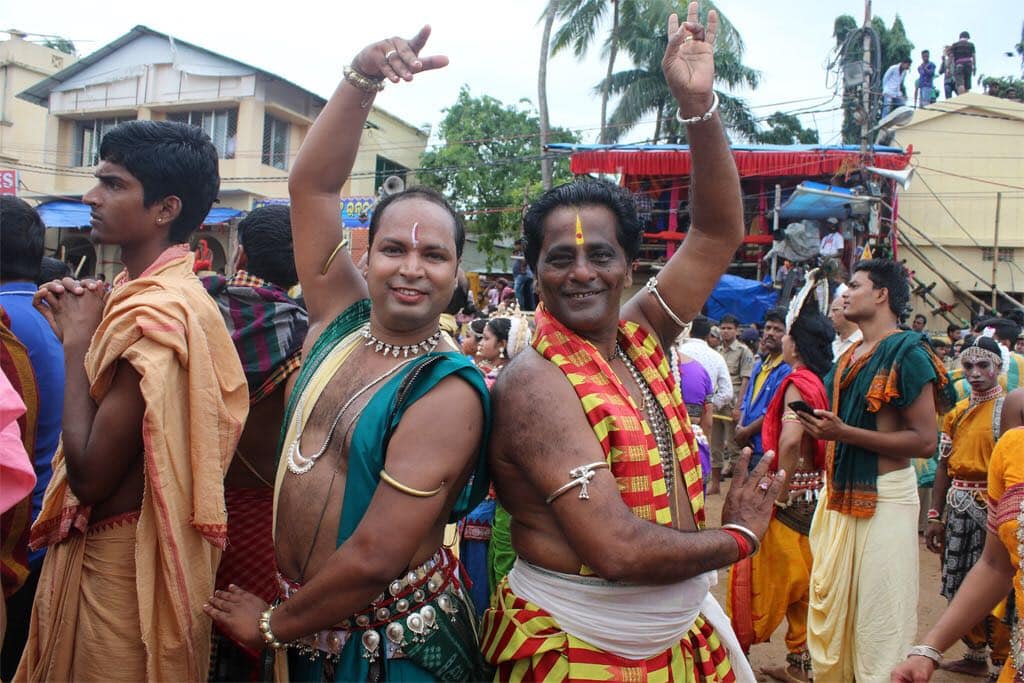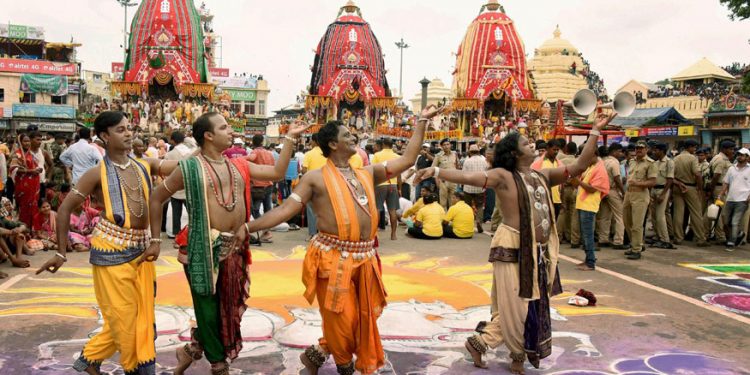Rath Yatra is perhaps the longest-celebrated festival of India, spanning 10 days. Come July 12 and millions of devotees will once again throng Gundicha Temple to witness Bahuda Yatra, which marks the conclusion of the festival. Bahuda Yatra, the return journey of Lord Jagannath, Lord Balabhadra and Devi Subhadra from Gundicha Temple to Puri Srimandir, is a grand affair too.
Rath Yatra is an opportunity for millions to show their devotion. The chariots, which are decked up in vibrant colours, with devotees trying to climb atop them is a spectacle in itself. Besides, a range of performances and services that take place on and in front of the chariots during Rath Yatra makes it even more interesting. The responsibility of performing these services every year has been vested on a few families for ages. Sunday POST speaks to a few servitors from families that have been performing these services for generations.
Fifty-nine-year old Girish Nayak from Kundheibenta Sahi of Puri, a servitor, has been performing ‘ghanta seva’ in front of the Trinity for 43 years now. Girish says, “Ghantuas or the ones who play the ghanta (gong) are integral to Rath Yatra. The ghantuas are split into groups and assigned to perform in front of the chariots. The strength of each group is fixed keeping in mind the number of wheels of each chariot. For example, Taladhwaja, the chariot of Lord Balabhadra, has 14 wheels. So, two ghantuas are assigned per wheel, making it a group of 28 ghantuas for Taladhwaja.”
Similarly, 24 and 32 ghantuas perform in front of Darpadalana, the chariot of Devi Subhadra, and Nandighosha, the chariot of Lord Jagannath, respectively. Girish says that the gong is called Bijaya Ghanta. “The ghantas can’t be played when the deities are on the Ratna Singhasana or Ratna Vedi. The ghantuas start performing only during Pahandi, when the Trinity steps out of Srimandir. It is like welcome music and the wheels of the chariots start rolling with the beat of the ghantas,” he explains. The entire process continues till the chariots reach Gundicha Temple, with the ghantuas taking a short break during Chhera Pahnara.

“My family has been performing this service for ages now. I have held the responsibility for more than 40 years now. I have also engaged my children in the service of the Lord. The temple administration has appointed us as ghantuas, but we carry out our responsibility with love and devotion. We can play uninterrupted for 12 to 14 hours and still not feel tired,” he says.
Like ghantuas, kahalias too play an important role when the deities step out of the temple. Kahalias or those who play the kahali (a musical instrument resembling a clarion or trumpet without reed) start their performance before the deities embark on their journey. Sixty-year-old Nabakishore Nayak from Puri takes pride in playing the kahali in front of the Trinity. “I was a servitor and have been playing the kahali for decades now. Earlier, kahali used to be blown before the start of a war,” says Nabakishore, who couldn’t participate this year due to health issues but has passed on the baton to his children. “I have taught my children the art of blowing a kahali as this responsibility has been vested with our family for years now.”
Rath Yatra is incomplete without the traditional Odissi dance. Kumar Bhimsen has been performing Odissi dance during Rath Yatra for the last 20 years. He is not sure for how many generations his family have been doing this service but is happy that he has been carrying on the tradition. The dancer says that earlier Maharis or devadasis would perform the 1,000-year-old dance form in front of Lord Jagannath in Srimandir. However, once the dance form came out of the temple, ‘Gotipuas’ (young male dancers wearing female costumes) started performing Odissi dance publicly. “For me, it is not dance but a devotional act in front of the Lord that I have been religiously performing for the last two decades,” says Bhimsen. “Lord Jagannath is the manifestation of love. He binds his devotees with his love. After watching people dance in front of his chariot, I decided to become a dancer. Every time, I perform in front of him, I feel it is a spiritual awakening. I feel there is no relationship holier or more beautiful than this. For me, dance is a medium to get closer to the Lord.”
Like Bhimsen, Narayana Pandey too has been performing Odissi during Rath Yatra for the past three decades. Every year, Narayana reaches Puri well in advance along with his disciples to perform in front of the chariots. “I will continue doing so till I am alive. I have performed at numerous prestigious venues but performing in front of the Trinity is a different kind of feeling that cannot be defined. It is perhaps the biggest stage with more than 10 lakh spectators watching you. Performing in front of the Lord under the open sky is a different experience altogether. I never feel tired and can go on dancing for hours,” he says.
There are several other services that are performed throughout the festive period. For many years now, septuagenarian Suna Gosain has been carrying flowers from Srimandir to the Rath when the Lord comes out for the procession and considers it a great opportunity to get close to the Trinity. “My family has been performing this service for years. It is a part of our life and I will continue doing this till my last breath,” she says.
Suna makes garlands with a variety of flowers and is grateful that the temple authority chose her family to perform this service. “At times, I think my health will not permit it, but once the Rath Yatra draws closer, I start feeling rejuvenated,” she adds.
Another important role is played by the Singharis or Pushpalak who decorate the Lord with flowers and garlands. Harihar Kar has been part of this effort since he was 20 years old and eagerly waits for this opportunity every year. “I have been doing this for the last 45 years. Earlier my forefathers used to do it. Making flower garlands takes time, but it gives me immense satisfaction because I am serving the Lord,” says Harihar, who is vested with the responsibility of making the ‘Tulasi Chula’ (a basil tiara that the Lord changes every day during the Yatra). A retired principal from Baseli Sahi, Puri, Harihar says, “I feel blessed to have been born in a family that has been engaged in this service for decades.”
There are many devotees who perform in front of the chariot during Rath Yatra and feel blessed. Shrikrishna Meher from Western Odisha attends Rath Yatra dressed up as Lord Hanuman every year. Shrikrishna, who moves along with the Rath every year, says, “Lord Hanuman is our ista devata. According to mythology, there is a deep connect between Lord Jagannath and Hanuman. I came to attend Rath Yatra for the first time in 2010. There I saw a person who was in the attire of Hanuman asking for water. I offered him water and he proposed that I should play Hanuman every year. Since then I come here every year.”
Another devotee Jagabandhu has been coming to Puri for the past 10 years during Rath Yatra in the attire of Lord Krishna. “Ten years ago, I came to Puri for Bol Bum and got an opportunity to perform in the holy city. Someone suggested that I should visit the city during Rath Yatra and since then I have been performing in front of the Lord in the attire of Lord Krishna,” he says.
BRATATI BARAL, OP







































